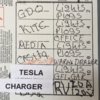So I got my 2015 Model S about 4 months ago and it came with dual chargers. I decided to put in an HPWC and went back and forth about how much power to give it. I didn’t want to overspend, but I also wanted to take advantage of the dual chargers since they were there. In the end it wasn’t significantly more to put in a 100 amp circuit to be able to charge at 80 amps, so that’s what I did.
As people predicted, I usually charge at night and I really would have had no problems with a lower amperage connection most of the time, but today I got in the car and started to run an errand and I was a bit shocked when I looked at the navigation screen and saw that it was precicting that I would arrive at my destination with 22% left. I looked down and realized that I only had a 35% charge because apparently I had completely forgotten to plug the car in last night.
I made it to my destination and back home with 7% left and I only had an hour before I needed to take another 50-60 mile round trip. Luckily with my 80 amp HWPC I was able to get enough charge in during that hour to make me feel comfortable about making that second trip without having to change my plans at all.
For those of you trying to make that decision it’s probably worth noting that I really only needed all 80amps once in the four months that I owned the car (and if I had actually remembered to charge last night I wouldn’t have needed it at all), but in this once case, at least, it was nice to have.
As people predicted, I usually charge at night and I really would have had no problems with a lower amperage connection most of the time, but today I got in the car and started to run an errand and I was a bit shocked when I looked at the navigation screen and saw that it was precicting that I would arrive at my destination with 22% left. I looked down and realized that I only had a 35% charge because apparently I had completely forgotten to plug the car in last night.
I made it to my destination and back home with 7% left and I only had an hour before I needed to take another 50-60 mile round trip. Luckily with my 80 amp HWPC I was able to get enough charge in during that hour to make me feel comfortable about making that second trip without having to change my plans at all.
For those of you trying to make that decision it’s probably worth noting that I really only needed all 80amps once in the four months that I owned the car (and if I had actually remembered to charge last night I wouldn’t have needed it at all), but in this once case, at least, it was nice to have.





